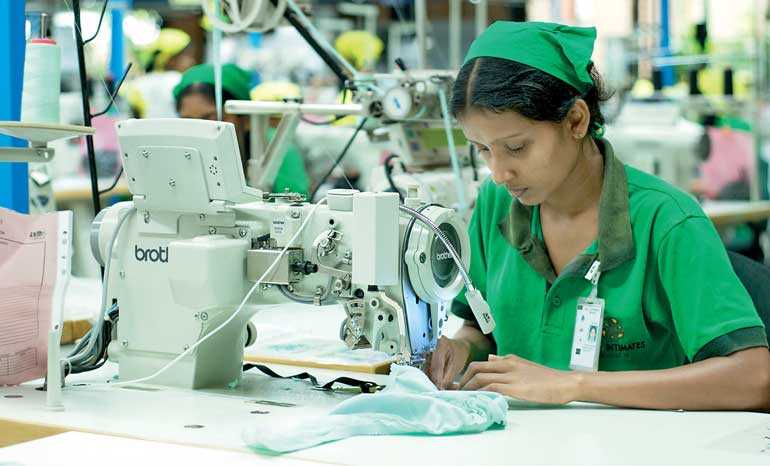Tuesday Mar 18, 2025
Tuesday Mar 18, 2025
Thursday, 21 February 2019 01:12 - - {{hitsCtrl.values.hits}}

The export figures in December 2018 saw Sri Lanka’s ready-made garments industry for the first time crossing the $ 5 billion mark for the first time in history. It is the first export industry that has achieved this number in Sri Lanka since the country was opened as a free economy in 1977.
The apparel sector has been and is a dynamic contributor to Sri Lanka’s economy for the last four decades and has helped the country to grow towards middle-income status nation and reduce poverty in many parts of the island.
The readymade garments industry of Sri Lanka is the primary export foreign exchange earner, accounting for over 40% of the total merchandise exports and nearly 50% of industrial products exports. This industry competes entirely in the international market place and has earned a reputation as a quality destination for sourcing among global buyers.
 Today Sri Lankan apparel manufacturers and suppliers are reputed worldwide for producing top quality ethical fashion apparel products and are trusted by the iconic global fashion brands as a reliable destination to source and secure a credible supply chain.
Today Sri Lankan apparel manufacturers and suppliers are reputed worldwide for producing top quality ethical fashion apparel products and are trusted by the iconic global fashion brands as a reliable destination to source and secure a credible supply chain.
Value to the economy underestimated or not understood
Some have been critical or negative of the industry without knowing the facts. Others are unaware that the net export foreign exchange income to the country by the apparel industry exceed the joint earnings of tea, rubber, coconut and few other products combined.
Today’s apparel sector value addition in some products is well over 50% to 60%, which was around 20% to 30% at the outset. In addition to this fact, the total trade value (exports and imports) accounts for over $ 7.5 billion, making the sector contribution of more than 20% to the trading sector GDP. Apart from this, they have created a massive second layer of industries and service providers who create wealth and employment in the domestic market which is not spoken of or recognised by many.
Impact to the country and economy is beyond exports
In addition to the foreign exchange earned through exports, the employment directly created would be more than 250,000. Many factories are located in rural or underdeveloped regions of the country as well as in the northern and eastern provinces where new factories were put up after the end of the conflict. This has created economic centres and ecosystems which has over the years helped the country to move into a middle-income nation and help reduce poverty in many districts.
The industry has been innovative, believes in competition and quality and partners the Government in policymaking rather than asking for assistance and handouts to sustain the business growth over the decades.
The achievement of $ 5 billion in export turnover was probably delayed due to the loss of GSP+ to Europe in 2011. Many opportunities were lost, and new challenges were faced by the industry as it had to compete under difficult circumstances including an overvalued currency at on time. If not, the ready-made garment industry would have been around $ 8 billion by now (if one observes the growth of the other nations who competes and had better market access to EU from 2011-2016).
With exports, many other sectors, such as suppliers, transport, logistics, shipping, insurance, engineering, technology and many other services and products such as packaging are value adding to the domestic economy creating an extra million jobs indirectly which is not noticed.
Economic value of imports for export processing?
There is a myth or a belief that exports must be near 100% domestic value addition. Many don’t understand that value chains can be created by two-way or multi-way trade. Others turn a blind eye to imports for export processing without understanding its economic value to the nation. Some describe it as a burden on the economy as foreign exchange flows outwards.
What they don’t realise is that in today’s global economy value addition can take place in different countries and that needs two-way trade of raw material, semi-finished goods, intermediaries and final products. Clear and simple examples are available from the high-tech industry such as airplanes and mobile phones which are well connected to the global supply chain at multiple points where groups of nations benefit out of two-way trading.
It is a smart charter of an industrialist’s ability to plug into the global supply where it matters with input and knowledge at an advantage point. It is the way forward for a small island such as Sri Lanka which can follow successful models such as Dubai and Singapore hubs have done to evolve as major global export hubs. In such locations, two-way trade has created thousands of jobs and wealth, making them first world economies
The import turnover of $ 2.5 billion of the readymade garment industry of Sri Lanka has helped it to be part of the global value chain although it does not command the luxury of raw materials. However, the multiplier effect to the economy is massive to say the least as a middle-income small economy.
The greatest beneficiaries of the apparel industry imports for export processing has been the local service providers. The derived demand for services such as ports, clearing agents, shipping companies, freight and logistics provides, warehouse operators, transporters, banks and insurance has created a large domestic ecosystem that is not at all talked of when the apparel industry is discussed in forums. Sadly, many only try to see and project the net revenue which incidentally also has been the number one among the export basket of Sri Lanka.
There are many more opportunities to Sri Lanka to do other products by using the readymade garment industry model as an example. This why we have been promoting the commercial hub concept again which was designed by the Joint Apparel Association Forum (JAAF) many years back along with the Government.
Sri Lankan exporters must now seek new partnerships and value chains with internationalisation of the production base to help widen the export base to support national needs and requirements; in fact at the National Export Strategy (NES) sectors such has boat building were recommended to look outwards to create new value chains to its business model as an Indian ocean hub.
Many have still failed to understand the success of JAAF and its model. If Sri Lanka wants to leap into a new era of export expansion, look at what our own entrepreneurs have done in the readymade garment industry where the competition is at the highest level externally.
I have been honoured to work with this industry, but as an independent multi-industry person involved in supporting exports, I would like to congratulate JAAF and its members for what they have achieved and contributed to the nation over the past four decades.
(The writer is the CEO of the Shippers’ Academy Colombo and Chairman of the Logistics Advisory Committee of the Export Development Board, a former Secretary General of JAAF and currently the Director General of the Sri Lanka Association of Manufacturers and Exporters Rubber Products.)
Discover Kapruka, the leading online shopping platform in Sri Lanka, where you can conveniently send Gifts and Flowers to your loved ones for any event including Valentine ’s Day. Explore a wide range of popular Shopping Categories on Kapruka, including Toys, Groceries, Electronics, Birthday Cakes, Fruits, Chocolates, Flower Bouquets, Clothing, Watches, Lingerie, Gift Sets and Jewellery. Also if you’re interested in selling with Kapruka, Partner Central by Kapruka is the best solution to start with. Moreover, through Kapruka Global Shop, you can also enjoy the convenience of purchasing products from renowned platforms like Amazon and eBay and have them delivered to Sri Lanka.
Discover Kapruka, the leading online shopping platform in Sri Lanka, where you can conveniently send Gifts and Flowers to your loved ones for any event including Valentine ’s Day. Explore a wide range of popular Shopping Categories on Kapruka, including Toys, Groceries, Electronics, Birthday Cakes, Fruits, Chocolates, Flower Bouquets, Clothing, Watches, Lingerie, Gift Sets and Jewellery. Also if you’re interested in selling with Kapruka, Partner Central by Kapruka is the best solution to start with. Moreover, through Kapruka Global Shop, you can also enjoy the convenience of purchasing products from renowned platforms like Amazon and eBay and have them delivered to Sri Lanka.